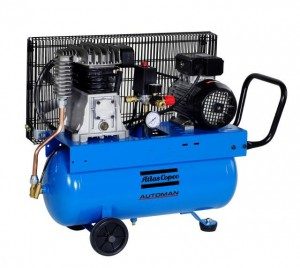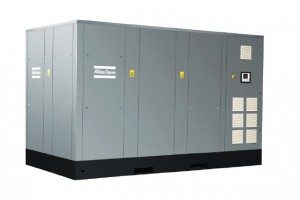Pressure and capacity are the two main specifications to look for when buying an air compressor.
- Pressure is expressed in bar or PSI (pounds per square inch).
- Capacity is expressed in CFM (cubic feet per minute), liters per second or cubic meters per hour.
Remember: pressure is ‘how strong’, capacity is ‘how much’.
What’s the difference between a very small and a very large compressor? It’s not the pressure, it’s the capacity.
 8 bar (115 psi) pressure, low capacity compressor!
8 bar (115 psi) pressure, low capacity compressor!
 7.5 bar (115 psi) pressure, high capacity compressor.
7.5 bar (115 psi) pressure, high capacity compressor.
Most compressors for sale at the various hardware shops and compressor dealers are between 125 and 175 psi ( 8.5 – 12 bar) pressure. But their capacity is the big difference. The pressure you need is dictated by the kind of tools / equipment you use (‘this nailer needs 100 psi’, or ‘the machine operates at 125 psi’). The needed capacity of your air compressor is dictated by the air consumption of all your tools and machines together (also depending how many you use at the same time).
What pressure do I need?
Most compressed air equipment is designed to operate at around 90 – 100 psi (6 – 7 bar). For this reason, most people only need a compressor with a maximum pressure of 7 bar.
 Pressure gauge
Pressure gauge
For some applications, an higher pressure is needed, like 15 or 30 bar. Sometimes even up to 200 – 300 bar or more (scuba diving and paintball for example).
So how much pressure do YOU need? Look at the tools or machines you use, it should state the required minimum pressure. If not, 100 psi (7 bar) is safe to assume for hand tools. Most machinery also operates at 100 psi, but to be sure check the specs or ask the manufacturer. If it is a replacement compressor, you can buy a compressor with the same pressure rating as the previous one.
What size/capacity (CFM) do I need?
Capacity is the amount of air that the compressor can pump out. It is expressed in CFM (cubic feet per minute) or liters per second or m3 per minute or hour.
What’s the difference between a very small and a very large compressor? It’s not the pressure, it’s the capacity. Again: pressure is ‘how strong’, capacity is ‘how much’.
 Flow meter
Flow meter
Tank size Now don’t be fooled by compressor manufacturers who state the size of the air tank (“a 200 liter compressor”). I see this a lot, especially for the smaller home/workshop compressors. Tank size doesn’t say a thing. It’s only a buffer between the compressor and the user. The capacity of the compressor is in ‘liters per minute’, not in ‘liters’. You can fit a very small compressor on a 1000 liter tank, but it will take ages to fill up the tank.
So, how much capacity do you need?
Add up the requirements for all the air tools and machines that you have. This is is the maximum capacity that your equipment requires together. That is, if you use all the tools and machines at the same time (which usually is not the case).
If you already have one or more compressors and need to buy a replacement machine, it is advisable to do a flow measurement to find out the maximum needed capacity.
